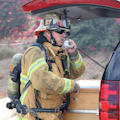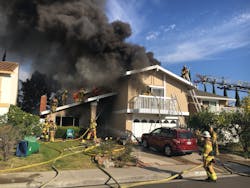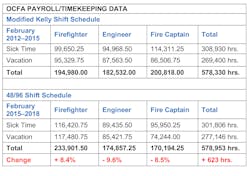Don't miss Ken Harrison's session, "The Implications of the 48/96 Schedule," on Thursday, March 28, at Firehouse World 2019.
When the discussion of which work schedule is best comes up at the coffee table in the firehouse, the 48/96 is frequently the most popular. The proponents will talk about decreased commutes, more mornings at home with family, high morale and increased productivity.
It doesn’t take long to find supportive information on the internet. The problem is that there is very little information related to the post-implementation effects of the schedule. The Orange County, CA, Fire Authority (OCFA) was one of those agencies that used internet-provided information to push for a change, and after years of resistance, ultimately shifted to the 48/96 schedule.
The OCFA went to the 48/96 shift schedule in February 2015. At first, it was as a pilot program, and then in July 2016, by a vote of the labor group membership, the decision was made to stay with that schedule.
I work with the OCFA, and in 2018, I undertook an independent study to assess impacts of that shift. The study was not an OCFA-sanctioned evaluation, but conducted in conjunction with the National Fire Academy Executive Fire Officer Program to see if the OCFA had in fact benefited from the change in work schedules. The methodology for the evaluation included a combination of descriptive research to gather the opinions of a percentage of OCFA personnel, coupled with evaluative research of the hard data related to sick leave and vacation usage and workers’ compensation claims and costs.
The first step in the evaluation involved conducting independent, informal surveys to see how a percentage of the personnel felt about the schedule. The questions on the surveys were separated into three categories:
1. On-Duty Impacts
2. Off-Duty Impacts
3. Organizational Impacts
Workforce opinions
The questions themselves related to quality of sleep, quality of relationships, fatigue, commute frequencies/times, number of overtimes (or, more importantly, forced overtimes), ability to complete projects, morale and communications. The responses ranged from “More rest, less fatigue. Feels like way more time with family/friends” to “Absolutely none. I never wanted to go to the 48/96. I have nothing positive to say about the schedule.”
So as not to operate in a silo, a similar survey was posted to the International Association of Fire Chiefs (IAFC) website to see what other agencies have experienced, post-implementation. Those surveys yielded 75 replies from agencies throughout the country. The external surveys were no different in that responses ranged from “Increased morale due to more time off” and “The guys love the schedule” to “Fatigue and sleep deprivation are the two biggest issues we have” and “Make no mistake, this is a firefighter schedule.”
Regarding organizational impacts, one must consider that the 48/96 schedule does create an environment whereby it can be 13 to 16 days between certain shift personnel and administrative or city personnel working on the same day. This was a frequent response from chief officers, from both inside and outside the OCFA, who frequently replied, “Difficulty in meeting the needs of the public and interacting with staff’ and “There are certain times where admin can go 16 days without seeing a particular shift.”
Hard data
While the surveys provided the perspective/opinions of those that have been working the 48/96 shift schedule, one of the benchmarks often used to support the 48/96 are the positive impacts to sick leave and vacation usage. The OCFA Payroll/Timekeeping Section provided the publicly available data for the time of February 2012 to February 2015, when the OCFA was on the modified Kelly shift schedule of 2/2/2/4, and compared it to the time of February 2015 to February 2018, after implementing the 48/96 schedule.
While the data suggests that there is an overall decrease in the percentages, in the end, the number of hours had increased, albeit nominal for an organization as large as the OCFA, with 1,100 sworn personnel. However, when studying the costs associated with workers’ compensation claims in cost, there was a significant difference, albeit there are limitations in that the costs are simply captured during that time period.
The below graph illustrates the workers’ compensation claims and associated costs for those two three-year time periods.
The data shows that the workers’ compensation costs climbed dramatically between the time periods. However, for full disclosure, an entire additional study would be necessary to determine the exact injuries, which shift these occurred on (i.e., first 24-hour period or second) and any other potential environmental impacts to determine whether there was a causal connection between the modified Kelly schedule and the 48/96 schedule.
Overtime issues
While one might argue the validity of the workers’ compensation data and sick leave utilization, there is no question that the 48/96 has a significant influence on the personal wellbeing of an agency’s firefighters, being positive or negative. Without comparison, the largest concern of both labor and management is the number of overtimes that each member is required to work to maintain the constant staffing requirements.
When an agency transitions from any modified Kelly schedule to the 48/96 shift schedule, the topic of constant staffing needs to be on the forefront. On a traditional shift schedule, an agency has 33 percent of the workforce coming on, and 33 percent going off duty, every given day. That being said, there is a large pool of personnel available to fill open positions, whether it be voluntarily or non-voluntarily. This is where the problem lies with the OCFA and most other large agencies that are large contributors/players to mutual-aid systems. The OCFA is one of the six contract counties in the State of California, a member of FireScope and a large player in the state master mutual-aid system, as well as the FEMA Urban Search & Rescue program. As such, it is not uncommon for the OCFA to have as many as 50 people out on assignments on any given day and gone for 14 to 28 days.
When one compounds the problem of people out on assignment, along with the common vacancies due to sick leave, vacation, workers’ compensation, specialized training, etc., plus vacancies due to attrition (currently the OCFA has 111 field vacancies), the impact upon individuals is daunting. Consider this: At the fire captain ranks, in March 2018 alone, there are 188 of the 243 fire captains who worked more than three forced overtimes. In the rank of engineer, there were 185 of the 248 who worked more than three forced overtimes per month, and in the firefighter or paramedic rank, there were 310 of the 480 who worked more than three forced overtimes. Additionally, with the structure of the 48/96 schedule, if there is an opening on one day, then there is an opening for two days. This has caused the line personnel to work more shifts than they ever asked for, or desired in the first place. In a conversation with a firefighter while this study was being performed, the following statement was made: “We don’t know what the benefits are because we have never tried the 48/96. We have been on a 96/48 since the day we went to this schedule.”
When reviewing the data for the OCFA firefighters, there was an average of 3.6 shifts of overtime per month (forced or voluntary) between September 2017 and March 2018. This is due to the number of vacancies that currently exist among all the ranks as is illustrated in the table below:
This is where the negative impacts of the 48/96 shift schedule are brought to the surface, and firefighters are subject to the true dangers of sleep deprivation, fatigue, increased instances of post-traumatic stress disorder (PTSD) and failing relationships. The surveys illustrated that both firefighters and chief officers consistently stated that the drawbacks to the 48/96 are not being able to fill the second shift during the state of a major or extended incident (i.e., a major wildland fire) or vacancies that require individuals to work their own two shifts plus two more, voluntary or forced. When this occurs, the extended amount of time away from family and lack of recovery time is a significant drawback to the schedule.
What seems to be one of the most concerning components of the 48/96 is the implication that it may have on two leading issues in the fire service—sleep deprivation and PTSD. A study titled “24/48 vs. 48/96 Work Schedules: A Comparative Analysis” conducted by Susan l. Koen, PhD, in 2005 took this subject and provided an in-depth analysis of potential impacts. Among many things that were studied were the work-to-rest ratio and how that impacts a firefighter’s alertness, fatigue levels and sleep deprivation, and the frequency of sleep disruptions and how that impacts the same.
Studies show that firefighters who experience one call during their nighttime sleep period will go into the next day with what is considered mild sleep deprivation. Those who experience two calls during the same time will be at a stage of moderate sleep deprivation, and those who have three or more calls (often common for large, busy-city stations) will be likely to enter the next day at a stage of being severely sleep deprived. Compounding this is the impact that fatigue has on mental wellbeing and the subject of PTSD.
Key takeaways
I imagine many of you are thinking, “The solution is simple—hire more people and promote more individuals into those vacant positions.” That is easy to say and hard to do for a few reasons, the first being that the current labor contract at the time of the study mandated having a specific number of vacancies in each position reserved for overtime opportunities (keep in mind the contract was signed at a time when positions were fully staffed and overtime was rare). The second reason is that both labor and management have agreed that promotional standards and hiring practices will not be adjusted to simply fill positions. In an effort to do just this, fill vacancies and promote, both labor and management have courageously led and agreed to reevaluate that contract, fill all positions and offer additional training and recruitment in the promotional processes to fill the positions without compromising quality and service. However, this still takes time and will not be resolved this month, or even this year, for that matter.
What the study did illustrate is that the 48/96 does have potential benefits:
· Increased time off in consecutive blocks
· Decreased number of commutes, which can equate to less expense in fuel and more time to focus on other pursuits
· Increased productivity if time management is properly utilized
· Improved quality of life off duty if one takes advantage of the opportunities to enjoy quality sleep and rest
· Increased opportunity for vacations and off-duty projects
All the potential benefits are true and real if the agency is fully staffed and operates predictably regarding emergency responses and continuity. There are cities that have experienced this, including San Jose, CA, the West Metro Fire Protection District in Colorado, and Albuquerque, NM. The challenge lies with the agencies where vacancies exist, have units with heavy calls loads (excess of 10 per shift) or are frequently involved with large-scale prolonged incidents (i.e., wildland fires, master mutual-aid participation).
If one views the workers’ compensation claims alone, the data illustrates that costs increased 17 percent over the past 3 years. However, while the sick and vacation usage for firefighters increased 8.6 percent, the engineer and fire captain ranks decreased a similar amount, which would make that factor a non-issue. If one considers the level of morale and the impact on the personal lives of the line personnel, in addition to the challenges to the communication lines, then the 48/96 had negative impacts.
All this being said, one might interpret the findings to show that the 48/96 schedule has not netted the results hoped for. The lesson for agencies considering the 48/96 schedule: Yes, an organization could experience the benefits that are discussed. However, there are also negative impacts if the work environment is not such to support the 48/96 shift schedule. It would appear that if staffing shortages exist, and there are high call load units or significant mutual-aid commitments, then the schedule may not deliver the potential benefits.
Sidebar: OCFA Facts
The OCFA is an agency comprised of approximately 1,400 personnel, with 1,100 of those being sworn. The agency provides all-risk emergency services to more than 1.7 million people out of 75 fire stations over a geographic area of 765 square miles. In 2017, the OCFA responded to 141,858 calls for service (2017 OCFA Statistical Annual Report), which was nearly a 10 percent increase over the responses just 2 years previous in 2015 (2015 OCFA Statistical Annual Report). Orange County is one of the 21 units, or counties, in the State of California, and the OCFA is contracted to protect the state’s interest in the areas that are referred to as State Responsibility Area (SRA). As such, the OCFA is a frequent player in the effort to fight wildland fires statewide and very active in the statewide mutual-aid system.
About the Author

Ken Harrison
Ken Harrison is a battalion chief with the Orange County Fire Authority (OCFA) and has been a member of the fire service for 27 years. In his career, he has held the position of firefighter/paramedic, fire captain and battalion chief. He has a bachelor’s degree from Long Beach State University, is a graduate of the National Fire Academy Executive Fire Officer (EFO) program, is a certified chief officer as well as a certified Master Instructor with California State Fire Training. During his tenure at the OCFA, he has been in the role of program manager for the Wellness and Fitness Program (WEFIT), Firefighter Academy Cadre, and he is currently the aircraft rescue firefighting (ARFF) program manager at John Wayne Airport.



